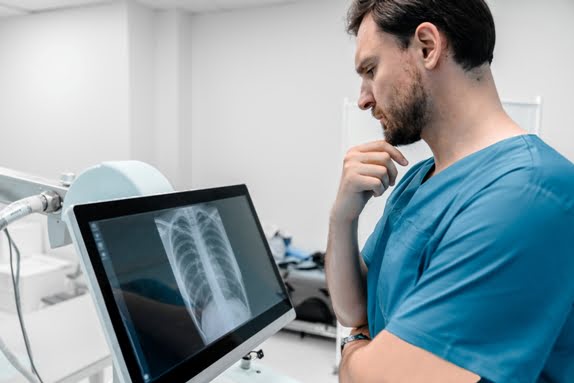What Is the Both Hands AP and Lateral X-ray?
A Both Hands AP (anteroposterior) and Lateral X-ray involves capturing two specific images of both hands at the same time. The AP view shows the hands from the front (or back) and allows the radiologist to assess the alignment of the fingers, metacarpals, and wrist joints. The Lateral view, on the other hand, provides a side profile of the hands, revealing additional details about joint spaces, bone structures, and alignment that may not be visible in the AP view.
Need a Both Hand AP/LAT X-ray in Pune? Visit the best digital X-ray centre near me at Diagnopein for accurate and high-quality imaging. The AP (anteroposterior) and LAT (lateral) views provide a comprehensive evaluation of the bones, joints, and soft tissues in both hands, essential for diagnosing fractures, arthritis, or other conditions. At Diagnopein, we use advanced digital X-ray technology to deliver precise results with minimal radiation exposure. Whether it’s for injury, pain, or pre-surgical assessment, our expert team ensures a smooth and efficient experience. Located in Pune, we’re your trusted choice for professional diagnostics.
Indications for Both Hands AP and Lateral X-rays
1] Fractures: Suspected fractures or bone injuries, including those of the fingers, metacarpals, and wrist bones.
2] Arthritis: To diagnose osteoarthritis, rheumatoid arthritis, or other inflammatory joint conditions that affect the hand.
3] Dislocations: Detecting dislocations or joint misalignments, especially in cases of trauma.
4] Infections and Tumors: Evaluating the bones for signs of infection (osteomyelitis) or growths like cysts or tumors.
5] Congenital Deformities: To assess congenital conditions affecting the bones and joints, such as polydactyly (extra fingers) or syndactyly (webbed fingers).
6] Post-Surgical Evaluation: To monitor the healing process after hand surgery, including fractures, joint replacements, or reconstructive procedures.
Technique for Both Hands AP and Lateral X-ray
AP View (Anteroposterior) : For the AP view, the patient is positioned with both hands placed flat on the X-ray table, palms facing down. The fingers are spread slightly apart to prevent overlap. The X-ray beam is directed perpendicular to the hands, and the image shows the bones of the hands and wrists in a frontal view. This view highlights the alignment of the metacarpals, phalanges, and joints, helping to identify fractures, dislocations, and degenerative changes.
Lateral View - In the Lateral view, the patient’s hands are positioned sideways with the fingers and wrist aligned in a neutral position. One hand may be placed on top of the other for optimal alignment. The X-ray beam is directed horizontally to capture a side profile of both hands. This view is particularly helpful for assessing joint spaces, detecting subtle fractures, and evaluating the position of the bones and joints. It also reveals any deformities in the hand's structure.
Benefits of Digital X-ray for Both Hands AP and Lateral Views
1] High-Quality Images: Digital X-ray systems produce clearer, more detailed images than traditional film, improving diagnostic accuracy.
2] Reduced Radiation Exposure: Digital imaging requires a lower dose of radiation compared to conventional X-rays, making it safer for patients.
3] Instant Availability: Digital X-rays can be viewed immediately after being taken, allowing for faster diagnoses and timely interventions.
4] Enhanced Image Manipulation: Digital images can be zoomed, rotated, or adjusted for contrast to better assess specific areas of interest.
5] Ease of Sharing: Digital images can be easily stored and transmitted electronically to other healthcare providers, facilitating second opinions or specialist consultations.









